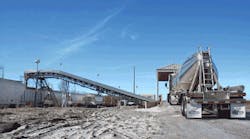OIL and gas shale activity plays a major role in operations at Southern Illinois Motor Xpress (SIMX) even though the carrier's fleet is based more than 200 miles from the nearest shale field. The dry bulk hauler averages 130 loads of frac sand a day, 363 days a year.
Based in Cutler, Illinois, SIMX has been running hard since 2007 in support of the latest oil and gas boom. The carrier serves oil and gas exploration and production customers with a fleet that includes 165 tractors and 350 trailers, 98% of which are dry bulkers or hopper trailers. Also part of the oil and gas shale support effort is a massive transload facility at the Cutler terminal that can accommodate more than 900 railcars.
“We got into frac sand hauling, largely because we are in the right location,” says Terry Oetjen, vice-president of marketing for Southern Illinois Motor Xpress. “We started with four trucks on the frac sand operation, and we never imagined it would become such a big part of our business.
“The oilfield boom and the demand for frac sand kept us growing right through the recession. In fact, this company has grown by as much as 30% to 40% a year, all of it capitalized internally. Oilfield customers need supplies, like frac sand, quickly. Transport rates generally aren't a big issue, getting the sand is.
“This also has become a very diversified transportation operation. In addition to the fleet, we offer transloading of dry and liquid bulk products. We have a logistics brokerage, named Southern Logistics. And we have a barge service on the Mississippi River that provides loading and unloading and operates seven tugs.”
Activity level
It's a level of activity hardly imagined when SIMX was founded 50 years ago. For the first 25 years, the company ran five trucks and hauled coal and grain. The shift to the dry bulk cargoes that account for most of the SIMX activity today came after Mark Arbeiter bought the carrier in 1988.
“Bulk really turned out to be the best fit for us. We're just more comfortable with it. We started with food products, including flour, corn meal, sugar, and vegetable oil. From there, we moved into industrial products, such as fly ash, cement, lime, clay, soda ash, calcium carbonate, crushed flint, and sand.”
The dry bulk hauler grew slowly, but steadily, and expanded its operating range beyond its south western Illinois base. The process was helped along by the acquisition of two smaller carriers in 1996 and 2003.
With these fleets came additional terminal locations. In addition to the Cutler headquarters terminal, SIMX has terminals in Cape Girardeau, Missouri; and Anna and Joppa, Illinois. All of the terminals have maintenance shops for routine vehicle service and minor repairs, and the Cape Girardeau location has a foodgrade wash rack that is open to other tank truck fleets.
Expansive terminal
One of the biggest facility changes experienced by SIMX came in 2001 when the carrier moved to the location that now serves as its headquarters terminal. SIMX bought a 540-acre complex that was part of the coal mine operation that closed down in 1996.
The complex included a large office building and even larger maintenance shops that had been used to overhaul underground mining equipment. “When we purchased this facility, our initial reaction was that it was way too big, but it has given us opportunity to grow and expand our capabilities,” Arbeiter says.
“We started out storing railcars, but it didn't take long to see the transload potential,” Oetjen says. “This has become a very busy part of our operation. We've found that railcar activity is a good predictor of economic growth, and right now the railcars are in high demand.
“Our transloading operation got a big boost when the frac sand plant opened in 2007. From the very outset, we got the transportation contract to manage both rail and truckload shipments. A hopper car holds four hopper trailer loads of frac sand, and we are filling 25 hopper cars a day.
“We've been so busy in recent months that we occasionally run out of hopper cars. These railcars typically are owned by the oilfield production companies.”
Short hauls
The quarry and plant that supply the frac sand are about 40 miles from Cutler. This is no ordinary sand. Fracking-quality sand must be round and have high compression strength. It is processed from crushed sandstone that is washed, dried, graded, and sized prior to shipment. SIMX also hauls resin-coated frac sand processed at another nearby plant.
SIMX uses hopper trailers for most of the frac sand movements from the processing plants to the transload facility. “We have 30 to 40 hopper trailers in the frac sand activity,” Oetjen says. “We chose those trailers for the plant movements because they are readily available right now, are light in weight, and unload quickly.”
Shorthaul and local truck movements account for 70% of the truck fleet activity. However, longhaul tractor-trailer shipments of frac sand and other cargoes also are an important part of the operation. Overall, SIMX serves customers in 40 US states and four Canadian provinces (Saskatchewan, Manitoba, Ontario, and Quebec). The average longhaul is 500 miles.
Over-the-road frac sand hauls typically are in the range of 500 to 600 miles. “In addition to emergency shipments, we have some regular truckload hauls (about 50 a day) of frac sand,” Oetjen says. “These loads usually go to distribution centers near the oilfields. We rarely deliver to a well site.”
Sand bulkers
Longhaul frac sand shipments are handled by a dry bulk fleet that is getting steadily younger. Over the past four years, SIMX has purchased a significant amount of new equipment, including 41 dry bulkers for sand.
Buying new equipment was a big change for SIMX, according to Arbeiter. “For many years, we bought nothing but used equipment,” he says. “That applied to both tractors and trailers. During the first 18 months of the recession, we bought 30 sand trailers because they were relatively cheap. We also sold off 20 of our oldest bulkers (some dating to 1967), and we know they went straight into oilfield service in Texas.”
Frac sand typically is hauled in 1,000-cubic-foot dry bulk trailers. Heil Trailer Inc supplied a majority of the dry bulk trailers in the fleet, but the carrier also bought some of its newest bulkers from Tremcar Inc and MAC Trailer Mfg.
Mack tractors
For tractors, SIMX shows a strong preference for Mack Pinnacles. The carrier bought 50 of the Mack tractors in 2011, and another 15 are on order. These purchases were for replacement and expansion, according to Oetjen.
“We're setting the engines at 65 miles per hour, which has been a big contributor to the improved fuel economy,” Oetjen says. “In addition, the 65 mph setting is critical for our trucks that operate in Canadian provinces where the maximum truck speed can't exceed 65 mph.”
All of the tractors in the fleet are outfitted with Qualcomm's on-board satellite tracking and communication system. “We are 100% Qualcomm and 100% electronic driver logs,” Oetjen says. “We believe that is having a positive impact on our roadside inspections and CSA (Compliance, Safety, Accountability program) scores.”
Driver team
Management believes the fleet renewal effort has helped attract good-quality drivers in a tight market without relaxing its qualifications. The carrier wants truck drivers who are at least 23 years old, have more than two years of truck driving experience, and a clean motor vehicle record for the past five years.
“We look for applicants with character and the understanding that they need to monitor their PSP score as well as their company's CSA score,” says Rob Arbeiter, SIMX fleet manager. “We want drivers who are focused on doing the right thing with every load they haul.”
SIMX gets help in the driver selection, screening, and management process from ITS Compliance, Sun Prairie, Wisconsin. The contractor also manages driver files, vehicle inspection reports, hours of service, fuel tax, and permits and licensing.
“Our partnership with ITS is allowing us to grow and keep the focus on our customers' needs while feeling confident that we are maintaining DOT compliance at the highest level,” says Rob Arbeiter.
SIMX and its employees demonstrate every day that they can meet oilfield customer needs without cutting corners in service or safety. It is a strategy that pays dividends with every shipment. ♦





















